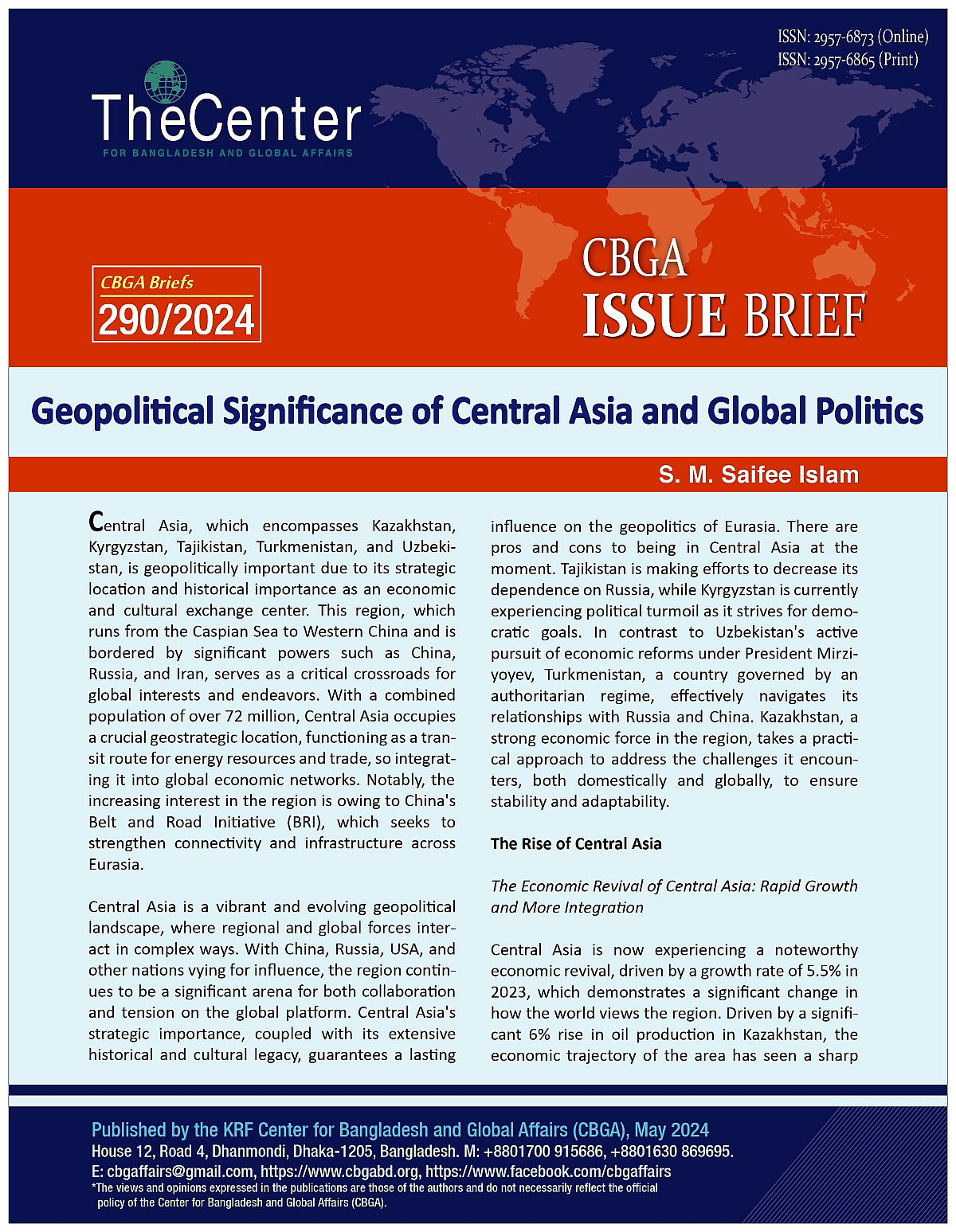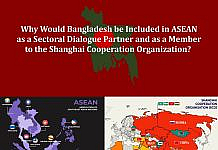
Central Asia, which encompasses Kazakhstan, Kyrgyzstan, Tajikistan, Turkmenistan, and Uzbekistan, is geopolitically important due to its strategic location and historical importance as an economic and cultural exchange center. This region, which runs from the Caspian Sea to Western China and is bordered by significant powers such as China, Russia, and Iran, serves as a critical crossroads for global interests and endeavors. With a combined population of over 72 million, Central Asia occupies a crucial geostrategic location, functioning as a transit route for energy resources and trade, so integrating it into global economic networks. Notably, the increasing interest in the region is owing to China’s Belt and Road Initiative (BRI), which seeks to strengthen connectivity and infrastructure across Eurasia.
Central Asia is a vibrant and evolving geopolitical landscape, where regional and global forces interact in complex ways. With China, Russia, USA, and other nations vying for influence, the region continues to be a significant arena for both collaboration and tension on the global platform. Central Asia’s strategic importance, coupled with its extensive historical and cultural legacy, guarantees a lasting influence on the geopolitics of Eurasia. There are pros and cons to being in Central Asia at the moment. Tajikistan is making efforts to decrease its dependence on Russia, while Kyrgyzstan is currently experiencing political turmoil as it strives for democratic goals. In contrast to Uzbekistan’s active pursuit of economic reforms under President Mirziyoyev, Turkmenistan, a country governed by an authoritarian regime, effectively navigates its relationships with Russia and China. Kazakhstan, a strong economic force in the region, takes a practical approach to address the challenges it encounters, both domestically and globally, to ensure stability and adaptability.
The Rise of Central Asia
The Economic Revival of Central Asia: Rapid Growth and More Integration
Central Asia is now experiencing a noteworthy economic revival, driven by a growth rate of 5.5% in 2023, which demonstrates a significant change in how the world views the region. Driven by a significant 6% rise in oil production in Kazakhstan, the economic trajectory of the area has seen a sharp boost. This growth has been supported by many causes, including decreases in inflation, increased government expenditure, remittances, and intensified commercial activity. Central Asia is becoming an important participant in global commerce and connectivity due to efforts such as the Belt and Road Initiative (BRI) and the Shanghai Cooperation Organization (SCO).
| Country | GDP (USD bn) | Inflation (CPI, ann. var. %, eop/aop) | Imports (USD bn) | Exports (USD bn) | Public Debt (% of GDP) | Foreign Direct Investment (USD bn) | International Reserves (USD bn) |
| Kazakhstan | 225 | 20.3 | 50.6 | 85.6 | 23.5 | 6.1 | 35.1 |
| Turkmenistan | 78.0 | 11.2 | 3.3 | 13.2 | 5.2 | 0.9 | N/A |
| Uzbekistan | 81.1 | 11.4 | 28.3 | 17.1 | N/A | N/A | N/A |
| Tajikistan | 10.5 | 6.6 | 4.6 | 1.6 | 34.6 | 0.2 | 3.8 |
| Kyrgyzstan | 11.5 | 13.9 | 9.2 | 2.2 | 49.2 | 0.3 | 2.8 |
These projects are increasing the region’s importance on the world stage. The growth of the economy, with a total GDP of $347 billion in 2021, was made possible by fundamental economic changes implemented in the 1990s. These reforms were further supported by favorable circumstances in global commodities markets. Furthermore, the rapidly increasing population of Central Asia, which presently stands at 77 million and is expanding at an annual rate of about 2%, offers a substantial market and workforce. This serves as a strong foundation for the region’s bright development prospects and ensures further economic prosperity in the future.
The Energy Landscape of Central Asia
Various influential entities, including Russia, China, and other regional and global powers, play pivotal roles in creating the energy environment of Central Asia. Due to its historical connections and economic stakes, Russia continues to have a substantial impact, especially in the domains of energy infrastructure and commerce. The Belt and Road Initiative (BRI) of China is crucial in promoting investment and infrastructural development in Central Asia, particularly in the energy sector. Additional parties, such as multinational firms and international organizations, have a role in influencing the energy landscape by investing, transferring technology, and implementing legislative efforts to enhance energy security and sustainability in the area.

Regional Integration and Economic Development via Connectivity
Central Asia is located at the intersection of important land transportation routes, and its current infrastructure and connectivity initiatives are expected to enhance its strategic significance and economic growth. The Middle Corridor, which encompasses the Central Asian steppe, Caspian Sea, and Caucasus Mountains, has emerged as a significant trade route option, drawing investments, and promoting economic development.
| Connectivity Initiatives | Description |
| Eurasian Northern Corridor | Historically significant route between northeast Asia and Europe, operated by the UTLC Eurasian Rail Alliance. Exploration of alternative routes to alleviate pressure on existing infrastructure. |
| Middle or Trans-Caspian Corridor | Promising overland option traversing Kazakhstan and connecting with Caspian ports. Requires significant investment to overcome infrastructure constraints and logistical challenges. |
| Multimodal Routes | Uzbekistan leads in pioneering multimodal transportation routes, leveraging road and rail networks to facilitate trade with China and beyond. However, logistical and regulatory hurdles exist. |
The China-Central Asia-West Asia Corridor, commonly referred to as this corridor, serves as a vital link connecting China and East Asia to Georgia, Turkey, and Europe. It provides improved security and shorter transit times, particularly in light of the tensions seen in conventional routes.

| Route/Corridor | Description |
| Middle Corridor | Spans the Central Asian steppe, Caspian Sea, and Caucasus Mountains. Connects China and East Asia with Georgia, Turkey, and Europe. Also known as the China-Central Asia-West Asia Corridor. |
| Northern Corridor | Includes the New Eurasian Land Bridge and Trans-Siberian Land Bridge through Russia. – Requires nineteen days for traversal. |
| Traditional Maritime Route | Passes through the Indian Ocean, taking twenty-two to thirty-seven days for transit. |
| International North-South Transport Corridor | Provides access to the Persian Gulf and Indian Ocean. |
| Bolashak-Chelyabinsk Railway Line | Kazakh section to be modernized for expanded connections and trade opportunities. |
| Kuryk Port | Targeted for development into a full-fledged logistics center similar to Aktau. |
| Aktau | Plans to create a container hub, expanding Kazakhstan’s maritime capabilities. |
| Dostyk-Moiynty Railway Line | Expansion planned to strengthen ties with neighboring countries like China and Uzbekistan. |
| Bakhty-Ayagoz and Darbaza-Maktaaral | New railway sections intended to enhance connectivity. |
| Baku-Tbilisi-Kars Railway | Completed in 2017, enabling rail passage through the Caucasus mountains. |
| Trans-Kazakhstan Railway | Opened in 2014, facilitating transportation along the Middle Corridor. |
The relationship between the European Bank for Reconstruction and Development (EBRD) and the European Commission is focused on doing research on sustainable transport linkages between Central Asia and Europe as part of their collaborative activities. The objective of these initiatives is to find the most efficient routes for transportation and suggest investments in infrastructure to enhance connectivity and stimulate economic integration.
To summarize, Central Asia has always been a melting pot of cultures and civilizations. From ancient Iranian-speaking peoples to Turkic expansions, the Silk Road trade routes, which fostered connections between Europe and the Far East, left a diverse heritage behind. However, throughout the colonial era, Russian influence spread, resulting in migration and demographic variety, notably in Kazakhstan. Central Asia is currently experiencing a significant period of change, characterized by the dynamic interplay between local and global influences, despite the enduring impact of Russian colonialism and Soviet rule. As countries compete for power, the region encounters a mix of favorable conditions and challenges. Nevertheless, these rivalries pose considerable challenges for these countries as they navigate the delicate task of balancing between multiple actors instead of aligning fully with just one. Consequently, this process has led to challenges of sluggish progress and significant involvement from external entities. In order for the region to fully tap into its potential, it is crucial to embrace a more collaborative approach.
– S. M. Saifee Islam is a Research Associate at the KRF Center for Bangladesh and Global Affairs (CBGA).







